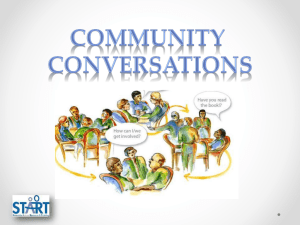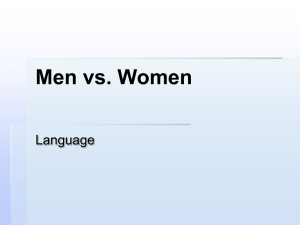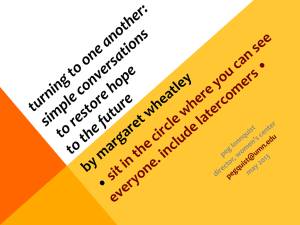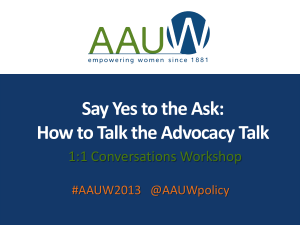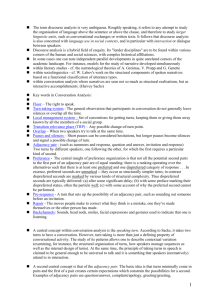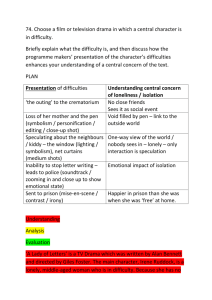Dsicourse and Pragmatics
advertisement
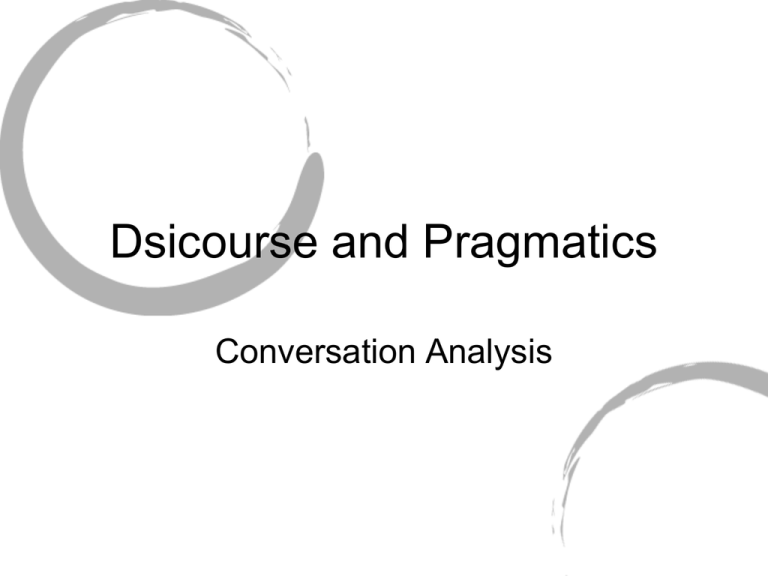
Dsicourse and Pragmatics Conversation Analysis Doing ‘Being Ordinary’ • • • • • Harold Garfinkle ‘Ethnomethodology’ How do people make interaction orderly? How do people make sense of interaction? Studying people’s actions on their own terms rather than with reference to a theory Conversation Analysis • Developed in the 1960’s by Sacks, Schegloff and Jefferson • Study of telephone conversations • Fine tuned (‘microanalytic’) analysis of the sequential structure of conversations • Conversation unfolds ‘one thing after another’ • No a priori assumptions • Looking for patterns in actual conversations • Understanding how people ‘make sense’ of conversations • Search for ‘patterns’ and ‘regularities’ in talk Topics in CA • How utterances are related to each other (‘adjacency pairs’) • Preference organization • Turn-taking • Topic initiation • Feedback • Openings and closings • Repair Context • Contrast with E of S and pragmatics • Only valid ‘context’ is the immediate context of the conversation • Context is dynamic • We create context by what we say and respond to the context other people create by what they say • Factors external to the talk is only relevant if participants make it relevant • ‘Pure’ conversational data • Based only on what participants actually do • Close data transcription Transcription • Transcription is… • A process of selection • Driven by analyst's theoretical stance • Gail Jefferson Transcription conventions Sample • • • • • • • • • • • • • • • • • • • • • Henry: Irene: Zelda: Deby: Irene: Zelda: Irene: Deby: Zelda: Irene: Henry: Irene: Henry Irene Henry: (a) Y'want a piece of candy? (b) No.// (c) She's on a // diet (d) // Who's not on a diet (e) =I'm on a diet. (f) and my mother // buys (g) // You're not! (h)=my // mother buys these mints.= (i) // Oh yes I// amhhh! (j) Oh yeh (k) The Russel Stouffer mints. (l) I said, 'I don't want any Mom." (m) "Well, I don't want to eat the whole thing." (n) She gives me a tiny piece. (o) I eat it. (p) Then she give me an//other,= (q) // Was, = (r) =so I threw it out the window= =there a lot of people?= (s) =I didn't // tell her.= (t) // Was there= The structure of conversations • Openings • Initiating exchanges that establish social relations • Middle • Topic negotiation and development • Turn taking mechanics • Feedback • Closings • Pre-closing exchanges • Closings • Meaning of an utterance depends on stage of conversation • ‘How are you?’ • ‘Hello’ Openings and Closings • Conversational ‘rituals’ • Vary from culture to culture • Closing telephone conversations in Australia and New Zealand Openings • Ritualistic openings • Utterances have different meanings when they occur at the beginning • ‘Hey!’ • ‘How are you?’ • ‘Have you eaten yet?’ • Summons--Answer • Greeting--Greeting • Often done simultaneously Openings in Telephone Conversations • • • • A: Hello. (…) B: Hello. A: oh, hello Anne, what’s up. B: Nothing much. I just had something I wanted to ask you. • Summons/Answer • Greeting/Greeting Closings • • • • • FTA Pre-closings Body language Excuses Ritualistic expressions (e.g. ‘good’, ‘ok’) • Signal invitation to or willingness to pass on one’s turn • Invitation for or offering of ‘unmentioned mentionables’ Why it’s so hard to get off the phone (Cameron) • From Cameron Adjacency Pairs • A pair of utterances in which the first part predicts the second part • ‘Conditional Relevance’ • Second half is functionally dependent on the first. • First is also dependent on the second: Second half provides evidence of how the first half was understood • ‘What makes something a request?’ • Speech Act Theory vs. CA • ‘Preferred Responses’ Dispreferred Responses • May create implicature • • • • A: I’m sorry B: … A: I love you. B: Thanks. • Second half of pair is heard as ‘officially absent’ Dispreferred Responses May require extra ‘conversational work’ such as ‘delay’, ‘preface’, and/or ‘account’. The ‘work’ involved is What identifies an utterance as ‘preferred’ or ‘dispreferred’’ Matching Adjacency Pairs • Cultural differences • ‘How was your weekend’ • Australians and French (Beal 1992) Insertion Sequences • • • • • • • • A: May I please speak to Rodney? B: May I ask who’s calling? A: Alan. B: Just a minute. I’ll get him. A: Gimme a beer. B: How old are you? A: 21 B: Okay. Coming up. • CONDITIONAL RELEVANCE Turn Taking • We ‘take turns’ in conversation • Turns are negotiated as we go along (conversation is ‘locally managed’) • ‘Turn Constructional Units’ • ‘Turn Transition Relevance Place’ • Choices • S nominates next speaker • If not, then… • Next speaker nominates self • If not, then… • Current speaker may (but does not have to) continue • ‘Accountable’ and ‘non-accountable’ silence • ‘Overlaps’ vs. ‘Interruptions’ ‘Supportive Interventions’ Turn Taking • Signaling the end of our turn • • • • • Adjacency pair structure Nominating another speaker Pausing Falling intonation/pitch Body language (e.g. gaze, body torque) Turn Taking • Signaling that we want to keep talking • Pausing in the middle of a phrase/clause • Looking away • Talking louder or maintaining pitch/loudness Turn Taking • Special situations have special rules for turn taking • Classrooms • Meetings • Can also be affected by… • • • • Topic Cooperativeness Power Distance Topic Management • • • • Appropriate and Taboo Topics Rules on who initiates topics How topics are initiated Changing topics Backchannel (Feedback) • Verbal feedback • Non-verbal feedback • Role in maintaining channel (‘focused interaction’) • Role in turn taking, topic management • Cultural differences Repair • Self-repair • Other-repair CA and Culture • An Argentinean in Sweden (Cameron) • Cultures where simultaneous talk is the norm • Cultures where extended silence is the norm Talk in institutional settings • What special considerations apply that make talk in institutional settings different from casual conversation? • Goal oriented • Special constraints on allowable contributions • Context specific inferential frameworks ‘One rule for one and one for another’
